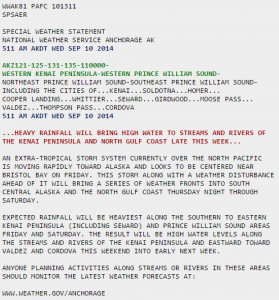First of all, this is not a tropical storm. It is an extra-tropical system.
Michael Lawson is a meteorologist with the National Weather Service. He says this system started out as a typhoon in the western Pacific, near Japan.

“It is the remnants of a tropical system, but at this time it doesn’t keep any of its tropical characteristics anymore,” says Lawson. “It’s made the transition to a colder core system as it comes up here.”
It was still south of the western Aleutians Wednesday afternoon. Lawson says in gaining latitude and interacting with the Jetstream, it’s gotten a colder core. But it’s still expected to bring some noticeable weather to the Aleutians, Kodiak, the Kenai Peninsula, and the Valdez, Cordova area.
“It is going to be interacting with a system in the Bering Sea here in the next couple of days and swinging a pretty potent front up into the northern gulf, which is where our rainfall and winds are going to come from,” says Lawson.
He says over the next few days, it will continue to move eastward. It’s expected to be south of Dutch Harbor and Unalaska Thursday afternoon.
“And that’s really when it’s going to start interacting with the upper level low pressure that’s currently over the Bering Sea,” says Lawson. “And it will really start to develop as it moves northward and that looks like it’s going to happen overnight Thursday into Friday.”
Lawson says the area around Unalaska, Cold Bay, and the Shumagin Islands may have some elevated winds. The heavy rains will likely fall on the Kenai Peninsula. But, the real brunt of the blustery weather should happen over the water.
“The main winds are going to be along Turnagain Arm and there will be a bit along the north Gulf Coast,” says Lawson. “But, for the most part this should be over the water and not affecting places like Cordova or Valdez.”
This extra-tropical system is expected to cover such a large area that, Lawson says, the Panhandle will likely be the only coastal area that doesn’t feel its effects.
Residents of the Kenai Peninsula who live near the Kenai River watershed are still advised to keep an eye on rising water levels and secure any loose objects near the water.
The Office of Emergency Management advises keeping weather radios handy and making sure they have batteries.
Weather forecasts and updates will be posted regularly online.




